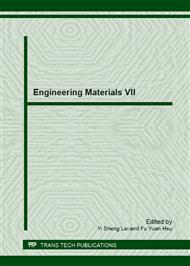[1]
Mario Tarantini, Arianna Dominici Loprieno and Pier Luigi Porta: A life cycle approach to Green Public Procurement of building materials and elements- A case study on windows, Energy, 2011, pp.1-10.
DOI: 10.1016/j.energy.2011.01.039
Google Scholar
[2]
Jui-Lin Chen, Wen-Ching Chen and Ming-Dao Che: The Practical Mechanism Model Planning and Studying for the Market of Green Building Materials, Collaborative Research Report in the Architecture and Building Institute, Ministry of the Interior, 2009.
Google Scholar
[3]
Architecture and Building Institute, Ministry of The Interior in Taiwan: Evaluation Manual for Green Building Materials, 2002.
Google Scholar
[4]
Xuan-Yang Chiu: Use Green Building Materials to Build High Quality Living Environment, Monthly Newsletter released by Environmental Protection Administration, Executive Yuan, No. 34, 2010. http://record.niet.gov.tw/Epaper/09934/3-3.html.
Google Scholar
[5]
Eduardo Peris Mora: Life cycle, sustainability and the transcendent quality of building materials, Building and Environment, Vol. 42, 2007, pp.1329-1334.
DOI: 10.1016/j.buildenv.2005.11.004
Google Scholar
[6]
Che-Ming Jiang, Chen-Cheng Chen, Chiang-Chang Li, Wen-Cheng Shao, Jui-Lin Chen, Ming-Chin Ho: A Study on Healthy Green Building Materials Applying ISO Standards to the Climatic Features of Taiwan, Journal of Architecture, No 62, Special Issue on Technology, 2007, pp.1-18.
Google Scholar
[7]
Xian-De Lin: Technology guides for green building design, Chan's Arch-Publishing Co., Ltd., Taiwan, 2010.
Google Scholar
[8]
Chi-Hsuan Dai: The value relevance of brand assets: A study of construction industries in Taiwan, Master Thesis, Feng Chia University Department of Accounting, Taiwan, 2008.
Google Scholar
[9]
Pei-Jen Tsai, A Study for Architectural Project Selection - An Example of Housing Project, Master Thesis, Chaoyang University of Technology Department of Architecture, Taiwan, 2004.
Google Scholar
[10]
Mohamed Osmani and Alistair O'Reilly: Feasibility of zero carbon homes in England by 2016: A house builder's perspective, Building and Environment, Vol. 44, 2009, P.1917–1924.
DOI: 10.1016/j.buildenv.2009.01.005
Google Scholar
[11]
Pei-Ying Lin and Xue-Cheng Liao: Applying the Fuzzy Delphi Method to Analyze the Greenway Functions of Lover River in Kaohsiung City, Jour. Exp. For. Nat. Taiwan University, Volume 22, No. 2, 2008, Page 89-106.
Google Scholar
[12]
Xiang-Yi Xu and Zhao-Xian Ye: A Study on the Urban Land Use Change Model from Perspectives of Location and Socio-economics- A Case Study of Land Consolidation in Taichung, Journal of the Land Bank of Taiwan, Volume 42, No 3, 2005, Page 161-187.
Google Scholar
[13]
Saaty, T. L., The analytic network process. RWS Publications, Expert Choice, Inc., 1996.
Google Scholar
[14]
Saaty, T. L. & Vargas, L. G., Diagnosis with dependent symptoms: Bayes theorem and the analytic hierarchy process, Operation Research, Vol. 46, No. 4, 1998, pp.491-502.
DOI: 10.1287/opre.46.4.491
Google Scholar
[15]
Tsuen-Ho Hsu & Ling-Jung Lin, Application of Fuzzy ANP Method on Evaluation of Brand Image in Taiwan, Taiwan Conference on Business and Information, 2006.
Google Scholar
[16]
Chen-Yuan Deng, Planning and Evaluation -Way and Application, Logistics Planning and Management Research Center, National Taiwan Ocean University, Keelung, 2005.
Google Scholar
[17]
Chii-Reid Wu, Using ANP Method to Evaluate the Subsidization Policy of the Irrigation Association Membership Fee, Journal of Hummanities and Social Sciences of NHCUE, Vol. 2, No. 2, 2009, pp.101-122.
Google Scholar
[18]
Yu-Hsin Lin, Kune-Muh Tsai, Wei-Jung Shiang, Tsai-Chi Kuo, Chih-Hung Tsai: Research on using ANP to establish a performance assessment model for business intelligence systems, Expert Systems with Applications, Vol. 36, No. 2, 2009, pp.4135-4146.
DOI: 10.1016/j.eswa.2008.03.004
Google Scholar


